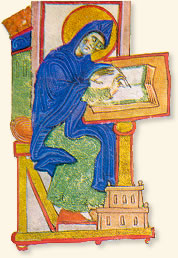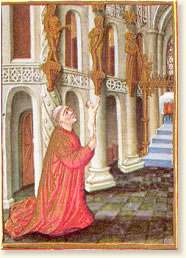|
Life in a Christian Monastery, ca. 585
In the latter part of the fifth century the barbarian hordes overwhelmed the last vestiges of the Roman Empire sinking Europe into what would come to be called the "Dark Ages." In defense, and under the influence of the Italian monk St. Benedict, monasteries spread throughout Europe. They provided islands of intellectualism as the world around them  devolved into anarchy. The monasteries preserved the intellectual legacy of Rome as well as the text of the Bible while simultaneously nurturing scholarship and the desire to maintain moral values. devolved into anarchy. The monasteries preserved the intellectual legacy of Rome as well as the text of the Bible while simultaneously nurturing scholarship and the desire to maintain moral values.
It was a harsh life. St. Benedict established the Benedictine Rule that reflected the two primary principles of monastic life - Ora et labora or prayer and work. The monks lived by a strict timetable of prayer, labor and study. Much of their day was spent in transcribing the Bible and ancient texts left from the Roman Empire, preserving these sources of knowledge for future generations.
Pope Gregory I (known as "the Great") served as head of the Church from 590 to 602. Prior to his elevation to this post he was abbot of St. Andrew's, a monastery on the outskirts of Rome. He wrote of his experience and provides us insight into daily living in a monastery and the moral structure that governed monastic life.
One of the rules set forth by St. Benedict specified that the monastery was to be a commune in which all possessions were held in common and personal property forbidden. Gregory recalls an incident in which a monk was found to have 3 gold pieces and describes the consequences of this transgression:
"There was in my monastery a certain monk, Justus by name, skilled in medicinal arts. . . . When he knew that his end was at hand, he made known to Copiosus, his brother in the flesh, how that he had three gold pieces hidden away. Copiosus, of course, could not conceal this from the brethren. He sought carefully, and examined all his brother's drugs, until he found the three gold pieces hidden away among the medicines. When he told me this great calamity that concerned a brother who had lived in common with us, I could hardly hear it with calmness. For the rule of our monastery was always that the brothers should live in common and own nothing individually.
Then, stricken with great grief, I began to think what I could do to cleanse the dying man, and how I should make his sins a warning to the living brethren. Accordingly, having summoned Pretiosus, the superintendent of the monastery, I commanded him to see that none of the brothers visited the dying man, who was not to hear any words of consolation. If in the hour of death he asked for the brethren, then his own brother in the flesh was to tell him how he was hated by the brethren because he had concealed money; so that at death remorse for his guilt might pierce his heart and cleanse him from the sin he had committed.
When he was dead his body was not placed with the bodies of the brethren, but a grave was dug in the dung pit, and his body was flung down into it, and the three pieces of gold he had left were cast upon him, while all together cried, 'Thy money perish with thee ! ' . . .
 When
thirty days had passed after his death, my heart began to have compassion on
my dead brother, and to ponder prayers with deep grief, and to seek what remedy
there might be for him. Then I called before me Pretiosus, superintendent of
the monastery, and said sadly: 'It is a long time that our brother who died has
been tormented by fire, and we ought to have charity toward him, and aid him
so far as we can, that he may be delivered. Go, therefore, and for thirty successive
days from this day offer sacrifices for him. See to it that no day is allowed
to pass on which the salvation-bringing mass is not offered up for his
absolution.' He departed forthwith and obeyed my words. When
thirty days had passed after his death, my heart began to have compassion on
my dead brother, and to ponder prayers with deep grief, and to seek what remedy
there might be for him. Then I called before me Pretiosus, superintendent of
the monastery, and said sadly: 'It is a long time that our brother who died has
been tormented by fire, and we ought to have charity toward him, and aid him
so far as we can, that he may be delivered. Go, therefore, and for thirty successive
days from this day offer sacrifices for him. See to it that no day is allowed
to pass on which the salvation-bringing mass is not offered up for his
absolution.' He departed forthwith and obeyed my words.
We, however, were busy with other things, and did not count the days as they
rolled by. But Io, the brother who had died, appeared by night to a certain
brother, even to Copiosus, his brother in the flesh. When Copiosus saw him
he asked him, saying, 'What is it, brother? How art thou?' To which he answered:
'Up to this time I have been in torment; but now all is well with me, because
today I have received the communion.' This Copiosus straightway reported to
the brethren in the monastery.
Then the brethren carefully reckoned the days, and it was the very day on which the thirtieth oblation was made for him. Copiosus did not know what the brethren were doing for his dead brother, and the brethren did not know that Copiosus had seen him; yet at one and the same time he learned what they had done and they learned what he bad seen, and the vision and the sacrifice harmonized. So the fact was plainly shown forth how that the brother who had died had escaped punishment through the salvation-giving mass."
References:
Gregory's account appears in Robinson, James Harvey, Readings in European History (1906); Evans, Joan (ed.), The Flowering of the Middle Ages (1985).
How To Cite This Article:
"Life in a Christian Monastery, ca. 585," EyeWitness to History, www.eyewitnesstohistory.com (2004).
|






